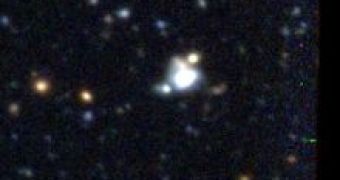Astronomers believe that a certain type of supernova explosions, called type 1a supernovas, all have the same intrinsic luminosity. This makes it possible to determine how far they are by considering their apparent luminosity and allows them to act like a sort of "standard candles" for measuring distances in the Universe.
When a white dwarf is accreting matter from a nearby star (such as a red giant) it gradually grows in mass. (For more information on white dwarfs and red giants see this article.) The white dwarf doesn't collapse under its own gravity because of the repulsion forces between the electrons inside the star. However, when the mass becomes too big (it exceeds a limit called the Chandrasekhar limit) the forces between the electrons can no longer support the star and a type 1a supernova explosion occurs. Because this accretion happens gradually the explosion always occurs at the same point and the same amount of energy is released. That's why they can work as "standard candles".
These explosions were famously used in 1998 by Saul Perlmutter from the Lawrence Berkeley National Laboratory and Alex Filippenko of the University of California for obtaining a very convincing evidence that the expansion of the Universe is accelerating. They have found that most of the type 1a supernovas are at least 15% further away than they should have been according to the standard model (which assumes the expansion happens at uniform speed).
This acceleration totally baffles astronomers because any acceleration must by the consequence of a force. But what is that force? The only known force capable to act at such distances is gravitation. However, gravitation is only attractive, while this accelerated expansion shows the presence of a repulsive force. The energy behind this mysterious universal repulsion is labeled "dark energy".
However, University of Toronto astronomer Andy Howell and his colleagues have now discovered a highly unusual Type 1a supernova that is about twice more luminous than it should have been. This discovery shows that at least some of the "standard candles" are not so standard after all.
"We've found a supernova that is so bright that it ought to have been impossible," Howell said. "Now we have to take a hard look at our theoretical understanding of Type 1a Supernovae and figure out how this could have happened."
The group carried of the research as part of the 5-year Supernova Legacy Survey, a joint venture between Canada, France and Hawaii. Researchers estimate that about 1 in 500 type 1a supernovas are similar to this one and they are concerned that their unaccounted presence "contaminates" the distance measurements.
"We'd still get roughly the right measurements, but it might not be as precise as it could be; especially when it comes to determining the nature of the dark energy that is driving the acceleration of the universe," said Howell. "Any knowledge of the extremes in which the 'candles' work and don't work will be essential for the kind of ultra-precise satellite missions that are being planned."
The team suggests that future studies should "screen out" such super-bright supernovae. However, according to the authors, this "contamination" of the data is not sufficiently large to undermine the idea of dark energy. The evidence that the expansion of the universe is accelerating is still in place.
The authors have also put forward two possible explanations for how "nature has found a way" to make white dwarfs get beyond the Chandrasekhar limit.
One possible explanation is that the white dwarf was spinning with an unusually large speed. Such a rotational speed might have produced a large centrifugal force that kept the star from collapsing, and thus also eventually exploding, for a long time, long enough that the star got quite far beyond the Chandrasekhar limit.
Another hypothesis is that they have actually witnessed a merger of two white dwarfs. The result of this merger was a white dwarf way beyond the limit, a star that soon imploded and produced the type 1a supernova.

 14 DAY TRIAL //
14 DAY TRIAL //